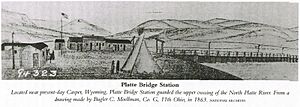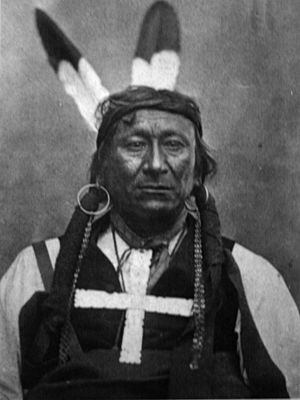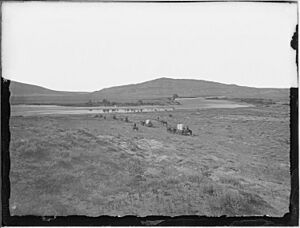Battle of Platte Bridge facts for kids
Quick facts for kids Battle of Platte Bridge |
|||||||
|---|---|---|---|---|---|---|---|
| Part of Colorado War, Sioux Wars, American Indian Wars | |||||||
|
|||||||
| Belligerents | |||||||
| Lakota Cheyenne Arapaho |
|||||||
| Commanders and leaders | |||||||
| Maj. Martin Anderson Capt. Adam Smith Leib Lt. Caspar Collins † Sgt. Amos Custard † |
Man Afraid Of His Horses Red Cloud Roman Nose Crazy Horse Dull Knife |
||||||
| Strength | |||||||
| 150 soldiers, a few civilians and Shoshoni scouts | 2,000 to 3,000 | ||||||
| Casualties and losses | |||||||
| 29 killed, 10 seriously wounded | 8 killed | ||||||
The Battle of Platte Bridge was a big fight between the Lakota and Cheyenne Native Americans and the United States Army. It happened on July 26, 1865, near what is now Casper, Wyoming. This battle was the main event of a summer of attacks by Native American tribes. They were fighting against U.S. Army outposts and stagecoach stations.
In May and June 1865, Native American warriors raided many places in Wyoming and Montana. By July, a large group of about 3,000 warriors gathered. They planned to attack Platte Bridge, a key crossing over the North Platte River. The bridge was guarded by about 120 soldiers. In the battles near the bridge and against a wagon train, the Native Americans killed 29 soldiers. They lost at least eight of their own warriors.
Contents
Why the Battle Happened
The Sand Creek massacre in Colorado in November 1864 made many Plains Indians very angry. About 4,000 Lakota, Southern Cheyenne, and Southern Arapaho people moved north. They went from Colorado and Kansas to join their relatives in the Powder River Country. On their way, they raided ranches and wagon trains. They also fought the army in battles like Julesburg and Mud Springs.
In the spring of 1865, the Lakota and Cheyenne decided to attack along the North Platte River. They sent messages to other tribes, like the Hunkpapa Lakotas. They hoped to launch a big, coordinated attack. This was one of the few times these tribes tried to work together on such a large scale.
Native American Strengths and Weaknesses
The Native American warriors were very brave and skilled. However, they had some challenges. They could only gather a large fighting force for a short time, usually a week or two. They also had few guns and not much ammunition. Their main weapon was the bow and arrow, which was not very effective against strong forts.
Native American warriors often fought for personal honor and to get horses. They did not have a strict command structure like the army. This made it hard to keep a large group together for long campaigns. Also, not all tribes or groups agreed on fighting. Some Lakota, like those under Spotted Tail, chose to stay peaceful near Fort Laramie.
U.S. Army Challenges
The U.S. Army also faced difficulties. Many soldiers were draftees from the American Civil War. Some were "galvanized Yankees," meaning they were Confederate soldiers who agreed to fight Native Americans to gain their freedom. With the Civil War ending, many soldiers wanted to go home. They were not eager to fight on the frontier. Many soldiers even deserted or threatened to refuse orders.
Early Skirmishes and Raids
Deer Creek Station: On May 20, a group of 100 Cheyenne warriors reached the North Platte River. They were near Deer Creek Station, where about 100 U.S. cavalry soldiers were stationed. The Cheyenne fought some soldiers outside the station. They captured 26 horses. The soldiers claimed to have killed five Native Americans. However, Cheyenne accounts say they had no casualties. The Cheyenne then rode north with their stolen horses. They also checked out Platte Bridge and attacked a wagon train, taking 250 mules.
Sweetwater and St. Mary's Stations: On May 26, Lakota warriors attacked stations west of Platte Bridge. Because of these attacks, the army closed the Oregon Trail to regular travelers on May 30.
Dry Creek: With the Oregon Trail closed, the Native Americans moved their attacks to the Overland Trail. On June 2, soldiers from Fort Halleck found three stage stations abandoned. They returned the workers to their posts, but the Native Americans raided again, stealing most of their horses.
On June 3, Native Americans tried to trick soldiers at Platte Bridge Station into an ambush. They fired at the station, and 22 soldiers chased them. Near Dry Creek, 60 Native Americans ambushed the soldiers. Two soldiers were killed.
Sage Creek Station: On June 8, about 100 Native Americans attacked Sage Creek Station. The soldiers and civilians there ran out of ammunition. They tried to escape but five of them were killed. The Native Americans continued to raid, focusing on taking livestock from stagecoach stations.
Yellowstone River Valley: Far to the north, in Montana, Lakota warriors killed a colonel and eleven other men in June. Attacks on small outposts and wagon trains continued daily throughout June and early July.
Colonel Moonlight's Actions
To stop the raids, Colonel Thomas Moonlight, the commander at Fort Laramie, led 500 cavalry soldiers. He searched for the raiding Native Americans but found none. One soldier said Moonlight was "hunting for them in [the] opposite direction [from] where their trail led."
Controversial Decisions
On May 26, Moonlight ordered the killing of two Oglala Lakota leaders, Two Face and Black Foot. A white woman, Lucinda Ewbanks, and her child had been living with their bands. They had been kidnapped earlier by Cheyenne and sold to the Oglala. Some accounts say the Oglala leaders brought the woman to the fort as a peace offering. However, Moonlight arrested and killed them. This action angered many Native Americans and even some civilians at the fort.
On June 3, the army decided to move about 1,500 Lakota and Arapaho people living near Fort Laramie. They wanted to move them 300 miles east to Fort Kearny in Nebraska. The Native Americans protested, saying Fort Kearny was in the territory of their enemies, the Pawnee. They also worried there would be no food. The army insisted. On June 11, the Native Americans left with 138 soldiers. However, the soldiers treated the Native American women and children badly. The young Oglala warrior, Crazy Horse, convinced the Native Americans to flee the soldiers. On June 14, near present-day Morrill, Nebraska, most of the Native Americans refused to go further. They crossed the North Platte River, helped by Crazy Horse. Four soldiers, including their leader, were killed trying to stop them.
Moonlight chased the fleeing Native Americans with 234 cavalry. He rode so fast that many of his men's horses gave out. On June 17, near present-day Harrison, Nebraska, the Lakota raided his horse herd. Moonlight lost most of his remaining horses. He and many of his men had to walk 60 miles back to Fort Laramie. His soldiers criticized him for not guarding the horses. On July 7, Moonlight was removed from his command.
The Main Attack on Platte Bridge
The Platte River bridge was a very important crossing point. It was used by wagon trains on the Oregon Trail and Bozeman Trail. Native Americans especially wanted to stop traffic on the Bozeman Trail because it went through their hunting lands. The bridge was nearly 1,000 feet long. On the south side was a military post with 100 soldiers, civilians, and Shoshone scouts. The soldiers were low on ammunition.
On July 20, Native American leaders decided to attack the bridge. Warriors gathered and marched south from the Powder River. The army was huge, estimated at 3,000 warriors. Leaders included Red Cloud, Old Man Afraid Of His Horses, Young Man Afraid Of His Horses, Roman Nose, Dull Knife, and Crazy Horse. The march was well-organized, with older warriors keeping the younger ones in line.
Ambush Attempts and Reinforcements
On July 24, the Native American army camped near Platte Bridge. Scouts checked the area. The next morning, warriors tried to trick soldiers out of the fort. Ten trusted warriors, including Crazy Horse, tried to lure soldiers across the bridge. But some excited young warriors appeared too early, spoiling the ambush. Crazy Horse and others rode across the river, surprising some soldiers, but did little damage. One Cheyenne warrior, High Back Wolf, was killed. The next morning, July 26, they tried the same trick again, but it failed.
Before dawn on July 26, a group of 14 soldiers arrived at the station. They were from Sweetwater Station and were heading to Fort Laramie for supplies. Their arrival brought the station's total to 120 soldiers. They told the commander, Major Martin Anderson, that a wagon train was coming from Sweetwater. The officers discussed sending a relief force to protect the wagons. Captain Adam Smith Leib and Lieutenant Henry C. Bretney suggested leaving right away, but Anderson decided to wait until daylight.
Lieutenant Caspar Collins' Sacrifice
When it was time to lead the relief force, all four of Anderson's officers refused. Some even pretended to be sick. So, 20-year-old Lieutenant Caspar W. Collins was ordered to lead the group. Collins had just arrived at the station. Bretney advised Collins to refuse the order, but Collins bravely agreed. He borrowed Bretney's pistols and got a horse.
At dawn, many Native Americans were seen watching the station from the hills. At 7:00 a.m., a large group crossed the river east of the station. They rode just out of rifle range, trying to provoke the soldiers. Collins and 25 soldiers crossed the Platte Bridge. They rode west along the north bank to drive off any Native Americans. Behind them, 30 more soldiers crossed the bridge on foot as support.
Suddenly, about 400 Cheyenne warriors appeared from the sand hills. Collins and his small group were heavily outnumbered. He ordered a retreat back to the bridge. At the same time, a large group of Lakota warriors rushed the bridge from the south. The soldiers at the bridge held them back with gunfire. Twenty-one of Collins's 26 troopers made it back, all wounded. Five were killed, including Collins, who was shot while trying to help a wounded soldier.
After the battle, Captain Bretney was furious. He accused the Kansas officers of being cowards because Anderson would not send more help. Anderson arrested Bretney. Disagreements also broke out among the Native Americans. The Cheyenne accused the Lakota of not capturing the bridge. The two tribes almost fought each other.
During the morning, the attackers destroyed a thousand feet of telegraph wire. Two Shoshone scouts were paid to take a message asking for help to the next telegraph station. But the battle was over before help arrived.
Battle of Red Buttes
Sergeant Amos J. Custard was in charge of five wagons and 25 men coming from the west. They were warned by another patrol that many Native Americans were in the area. Custard refused to take cover, saying his men knew how to fight. He and his men continued until they were about five miles from Platte Bridge Station. They heard the sounds of the battle there. Custard sent five troopers to investigate. They were cut off and chased by 100 Cheyenne warriors. One Cheyenne leader, Left Hand, was killed in the chase. Eventually, three of the troopers made it back to the station on foot.
At the wagon train, many Native Americans surrounded Custard's group. Custard arranged the wagons into a circle near the river. They fought off a first attack. Then, Native American leaders like Roman Nose arrived. They rode their horses in circles around the wagons. Their goal was to make the soldiers use up all their ammunition. Once the soldiers had little ammunition left, the Native Americans attacked on foot. They quickly overwhelmed the wagons, killing all 22 soldiers inside. Only one wagon driver escaped.
U.S. Army reports say the fight lasted four hours. However, George Bent, who was there, said it lasted only about half an hour. He admired the soldiers for holding off 1,000 Native Americans for that short time. Bent said eight Native Americans were killed in this battle and many were wounded.
What Happened Next
The day after the battles, the large Native American army broke into smaller groups and left. Some stayed near the Oregon Trail for more raids, but most returned to their villages. They went to the Powder River country for their summer buffalo hunt. Native American armies usually could not stay in the field for a long time.
The Native Americans' achievements were somewhat small, considering it was perhaps the largest Native American army ever gathered on the Great Plains. Their planned attack on Fort Rice in North Dakota never happened.
The U.S. Army lost 29 soldiers, including Lieutenant Collins, and at least ten were seriously wounded. The Native Americans had few casualties, with George Bent reporting only 8 killed at Red Buttes and very few near the Platte Bridge. Native Americans usually avoided heavy losses in attacks.
The Army later renamed Platte Bridge Station to Fort Caspar to honor Lieutenant Collins. They used his first name to avoid confusion with another fort named after his father.
The Native Americans were lucky they ended their campaign when they did. A large army of more than 2,000 soldiers, led by General Patrick Edward Connor, was preparing to attack them. This was called the Powder River Expedition. It would go into the heart of their territory in August. By that time, most of the warriors from Platte Bridge were back in their camps, rested, and ready to successfully defend their lands against Connor.




